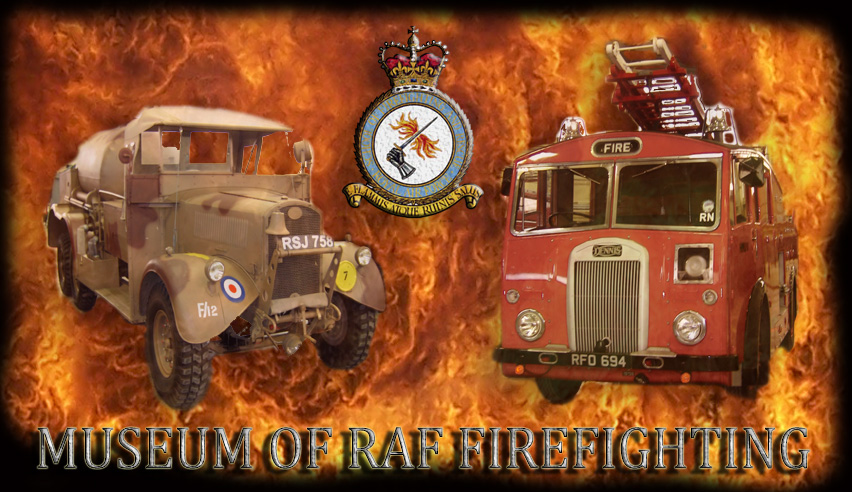
The owner and founder of the Museum is WO Steve Shirley MBE, who during the 1990's was an instructor on the staff of the CTE and the roots of the present museum go back some thirty years when he obtained his first model fire engine. He started collecting fire related items as a hobby and the collection now runs into many thousands of individual items. For instance, on a visit to Holland some years ago, he acquired several helmets from a Dutch Firefighter and things being as they are, it eventually led to the superb display of over 150 helmets from all over the world which form a large part of the Museum display of today. The collection continued to grow and on his posting to the CTE, it became obvious to everyone that a permanent home for the collection was a priority and it was agreed that it should be displayed in the current building as a tribute to the firefighting Services from around the world. It was officially opened as the Ministry of Defence Fire Museum in June 1995 and it was renamed the Manston Fire Museum in November 1998.
The collection consists of many photographs and posters on display alongside models, badges, patches, uniforms, helmets, prints, extinguishers and, of course, really serious fire fighting equipment, both military and civilian ranging from 1868 to the present day.
Later, Steve managed to acquire new premises at RAF Scampton and with the help of fresh volunteers the collection grew at a tremendous rate over following years. In 2014 the collection was consolidated at Scampton and the Manston Site was vacated and by this time the museum had become a major tourist attraction in Lincolnshire gaining high praise through Trip Advisor. The galleries below show just some of the displays and many vehicles he now has While the majority of vehicles are garaged in the old Blue Steel sheds, the main display area is shared with a Station Museum which also has some great memorabilia, including some excellent artefacts from the Dambusters. To add to the historic atmosphere, all of this is in the hangar used by 617 Squadron prior to the famous raids with Nigger’s grave outside the main entrance.
Despite having gone to a lot of effort and expense developing the Hanger Annex, the museum was dealt a cruel blow in the latter half of 2015 when the Station Commander announced that it would be needed for the forthcoming air-
In late 2018 the Museum of RAF Fire Fighting moved to a new storage facility in Scunthorpe supplied by North Lincolnshire Council with a one year lease which enabled the volunteers to store the collection until a new “Home” could be found. This venue provided an ideal set up for the collection and it was hoped that a long term solution could be arranged but alas the Museum was yet again given notice to seek new premises in 2020. Despite the Covid restrictions in place at the time, a former car sales room was acquired at Alford and the staff once again commenced the mammoth task of relocating the ever-
Consequently, the collection is now housed at a variety of locations around Lincolnshire and as Covid restrictions are gradually eased the volunteers are able to show off parts of the collection at public events and keep the wheels in motion.
Fortunately, there is one ray of hope that should it come to fruition, could well see the Museum of RAF Firefighting find a permanent home in the not too distant future. In August 2021 the Museum went into partnership with Scampton Holdings Ltd which will hopefully lead to an incredible opportunity for the museum to secure its future with a purpose built facility on the grounds of RAF Scampton once the base is disposed of by the MOD. Look at the full article in our updates for more information and links to the Scampton Holdings Ltd website. This plan is still years in the making so we need all the support, no matter how small, to ensure the collection survives to be opened back up to the public when the opportunity arises. To follow developments please see its own dedicated website which can be viewed at http://firemuseum.co.uk/.
STATIC DISPLAYS
VEHICLES
There are literally dozens of fire appliances at Scampton in various states of restoration and repair. The following galleries show just some of those that have been on display for visitors.
GXN219 -
One of only 50 produced, and painted grey to confuse enemy aircraft, this vehicle was built by Merryweather for use by the National Fire Service during World War II. It is powered by a 4Ltr petrol engine which does approximately 8 mpg and has a top speed of 30mph. The ladder extends to 60 feet and would originally have had to be put up by hand. They were later converted to work off the vehicle gearbox. The pump on the front is driven by the engine and was made by Barton (USA). It is fully equipped as it would have been at the time for a crew of 4 including the driver. This particular vehicle spent most of its service in London but finished in Wales. It was fully restored in 1986 and joined the Manston Museum in 2002. It has been to many shows and schools and also had a part in the film Mrs Henderson which was about the Windmill Theatre during the war.
RSJ758 -
This tender on display was one of the first fire tenders to be used during the advance after the D-
In 2004 Mr Corbin kindly loaned it to the Twinwood Museum at Clapham Beds. This is where Glen Miller was based and flew from. Then in July 2008 Mr Corbin took it to the War & Peace show and displayed it with the Manston Fire Museum display. It then went on loan to the Manston Fire Museum who in 2009 purchased it, and it will be displayed in the Museum and at various shows throughout the UK.There are only 3 of these vehicles left. One is in the Spitfire Museum at Manston, there is another at East Kirby and this one is the only one in camouflage out of a total of 6 which went abroad. This vehicle is fully operational and kitted as per wartime.
The WOT1 was used as a major foam tender by the RAF and American Air Force Fire Services during WWII on all of their operational airfields on both fighter and bomber stations from 1941 to 1952. The vehicle was manned by a crew of five, 1 MT Driver and 4 Firemen; the MT Driver would act as pump operator. One Fireman would be dressed in an asbestos suit ,for rescue duties, the others who operated the foam hose lines would be dressed in overalls, leather jackets and rubber boots, and a steel helmet with a skirt to cover the head and neck area. They were also equipped with an axe & belt and a quickrelease knife for cutting aircrew harnesses.
Leading Particulars:
30 HP Ford Engine,
400 Gallon Water Tank and a 65 Gallon Foam Tank,
Power Take Off Pump Drive
4 X 2½ inch Side Line Hoses
Pump Air Foam Induction System
This is a unique prototype of a Green Goddess. The refurbishment program was never authorised for the rest of the fleet so this remains the only example.
This was the very first TACR 1 built. It was rescued from a race course near Dover.
Probably the most iconic truck ever, this early example is being lovingly restored by Steve Harrison and Dave Jenner. By a quirky coincidence, Steve actually drove this machine whilst Stationed at Wyton and has provided us with the following information:
MK6 23 AG 56, was built in 1956 and was the first production Mk6 to come into service, having the chassis No FCT01. It didn't come into 'active duty' until 1958. It saw service in Coastal, Transport, Training, Fighter and Maintenance Commands though records only mention Catterick, Aldergrove and Wyton as Units where it was stationed. There was a request in 1971 for it to be kept at Catterick Museum, but the records show it was at RAF Wyton until 1976, after which it was downgraded to ‘Instructional Assembly'.
This vehicle was previously stored at Barkston Heath before it was acquired by the Museum.
This vehicle was the first Mk9 to be delivered to the RAF (Serial No 1) and is currently wearing the livery of Falklands Islands to commemorate the 30th anniversary of the campaign. It recently took pride at a WAR AND PEACE show in Kent, and was at Manston during its Service with the RAF.
This vehicle came into service in July 1983 bearing the registration number 31AG76. It was later converted into a Mk10E and finished it’s RAF career at Benson.
EMP85K -
This was Steve's second fire engine and remains the love of his life (after family of course). Formally a Sussex Fire Brigade Appliance it was re-

FOLLOW US ON FACEBOOK


| Austin |
| WOT1 |
| Green Godess |
| TACR1 |
| TACR2 |
| Mk6 |
| Mk8 |
| Mk7 |
| Mk9 |
| Mk10 |
| TQF Appliance |
| Mk11 |